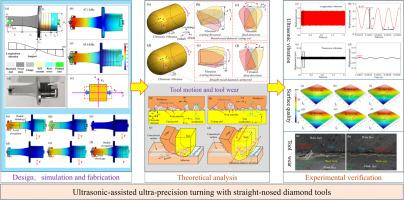超声波辅助直角金刚石刀具超精密车削硒化锌
IF 7.1
1区 工程技术
Q1 ENGINEERING, MECHANICAL
International Journal of Mechanical Sciences
Pub Date : 2024-11-12
DOI:10.1016/j.ijmecsci.2024.109823
引用次数: 0
摘要
本研究提出了一种新型超精密加工技术,利用超声波振动和直角金刚石刀具来改进脆性光学材料硒化锌(ZnSe)的加工。在超声波振动辅助单点金刚石车削过程中,泊松效应会引起沿切削深度的弯曲振动,从而降低加工效率和表面质量。本研究采用理论和实验方法分析了金刚石刀具边缘的一维超声波振动与诱导弯曲振动之间的关系。通过研究进给方向和直切削刃上的超声波振动动力学,结果表明超声波振动有助于改善切削区域的韧性-脆性过渡比和表面质量。这些改善是通过调节刀具切削刃的切削位置、调整切削参数和优化超声参数实现的。在使用直头金刚石工具进行超声波振动时,如果进给率较高,硒化锌的加工表面粗糙度会降低约 30-46%。研究结果表明,这项新技术具有减少刀具磨损和脆性断裂的潜力,从而解决了光学材料超精密加工的难题。本文章由计算机程序翻译,如有差异,请以英文原文为准。

Ultrasonic-assisted ultra-precision turning of zinc-selenide with straight-nosed diamond tools
This study proposes a novel ultra-precision machining technology that uses ultrasonic vibration and a straight-nosed diamond tool to improve the processing of the brittle optical material zinc selenide (ZnSe). This research addresses the challenges posed by Poisson's effect in ultrasonic vibration-assisted single-point diamond turning, which causes bending vibration along the depth of cut, resulting in lower machining efficiency and surface quality. This study analyses the relationship between one-dimensional ultrasonic vibrations at the diamond tool edge and induced bending vibrations using both theoretical and experimental methods. By investigating ultrasonic vibration dynamics in the feed direction and at the straight cutting edge, the results showed that ultrasonic vibration helps to improve the ductile-brittle transition ratio of the cutting area and surface quality. These improvements are accomplished by regulating the cutting position at the tool cutting edge, adjusting cutting parameters, and optimizing ultrasonic parameters. The machined surface roughness of ZnSe is reduced by approximately 30–46 % at higher feed rates under ultrasonic vibration with straight-nosed diamond tools. The findings demonstrate the potential of this novel technology to reduce tool wear and brittle fractures, resolving the challenge of ultra-precision machining for optical materials.
求助全文
通过发布文献求助,成功后即可免费获取论文全文。
去求助
来源期刊

International Journal of Mechanical Sciences
工程技术-工程:机械
CiteScore
12.80
自引率
17.80%
发文量
769
审稿时长
19 days
期刊介绍:
The International Journal of Mechanical Sciences (IJMS) serves as a global platform for the publication and dissemination of original research that contributes to a deeper scientific understanding of the fundamental disciplines within mechanical, civil, and material engineering.
The primary focus of IJMS is to showcase innovative and ground-breaking work that utilizes analytical and computational modeling techniques, such as Finite Element Method (FEM), Boundary Element Method (BEM), and mesh-free methods, among others. These modeling methods are applied to diverse fields including rigid-body mechanics (e.g., dynamics, vibration, stability), structural mechanics, metal forming, advanced materials (e.g., metals, composites, cellular, smart) behavior and applications, impact mechanics, strain localization, and other nonlinear effects (e.g., large deflections, plasticity, fracture).
Additionally, IJMS covers the realms of fluid mechanics (both external and internal flows), tribology, thermodynamics, and materials processing. These subjects collectively form the core of the journal's content.
In summary, IJMS provides a prestigious platform for researchers to present their original contributions, shedding light on analytical and computational modeling methods in various areas of mechanical engineering, as well as exploring the behavior and application of advanced materials, fluid mechanics, thermodynamics, and materials processing.
 求助内容:
求助内容: 应助结果提醒方式:
应助结果提醒方式:


